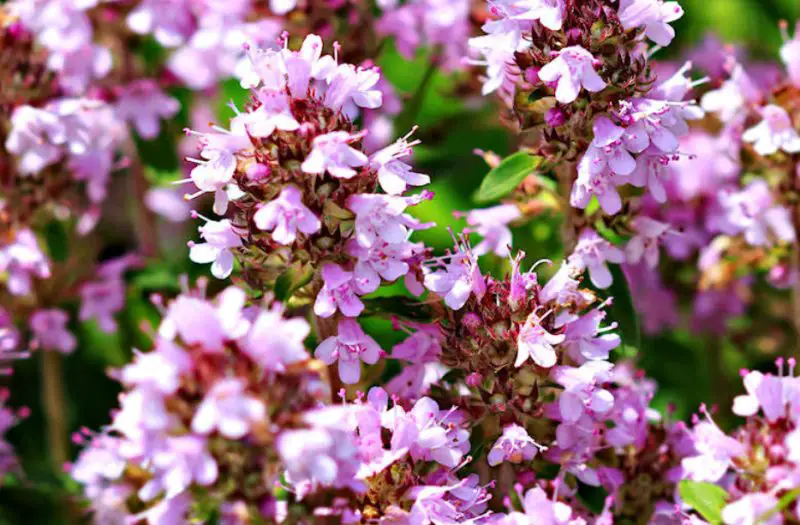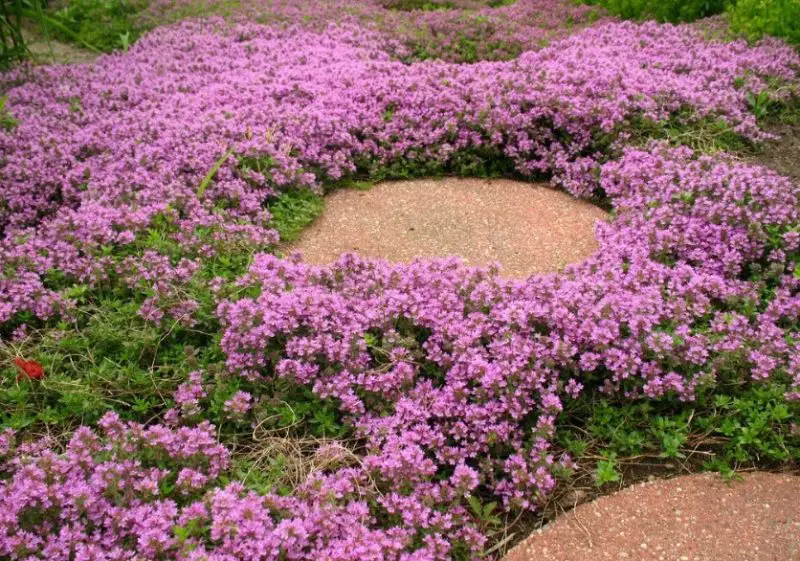To unlock the full potential of Creeping Thyme and ensure a thriving garden, a comprehensive understanding of its care and growing requirements is essential.
In this guide, we will delve into the intricacies of Creeping Thyme seeds, offering insights into the optimal conditions for germination, the nuances of ongoing care, and the steps to foster a lush and fragrant outdoor haven.
About Creeping Thyme

Creeping Thyme, a beloved and versatile dwarf ground cover, has firmly established itself as a favorite in landscape designs. Its adaptability makes it a sought-after choice for various applications, particularly as borders for flower beds and nestled between pavers on walkways. This resilient ground cover possesses the remarkable ability to withstand moderate foot traffic, making it an ideal solution for both aesthetic and functional landscaping purposes.
One of the standout features of Creeping Thyme is its robust resistance to diseases and insects. This low-maintenance quality adds to its appeal, making it an attractive option for gardeners and landscapers alike. The plant not only serves as a visual delight but also as a protective barrier for other vegetation, offering a natural defense against potential threats to vegetables and ornamental plantings.
The lush and vibrant appearance of Creeping Thyme adds a touch of natural elegance to any outdoor space. Its cascading foliage creates a carpet-like effect, transforming ordinary flower beds into enchanting displays of color and texture. Whether used to define the edges of a garden or to fill the gaps between stepping stones, Creeping Thyme brings a sense of cohesion and beauty to the overall landscape design.
The Best Time to Grow Creeping Thyme Seeds
Determining the ideal time to plant Creeping Thyme seeds is crucial for ensuring a thriving herb garden. Creeping Thyme, a resilient perennial herb, demonstrates excellent winter endurance, particularly flourishing in zones 4-9. For those eager to witness the enchanting spread of this ground cover, strategic timing is essential.
The recommended window for direct sowing of Creeping Thyme seeds is late spring, precisely when outdoor temperatures consistently reach the balmy range of the high 60s or above. This timing aligns with the plant’s natural growth cycle, allowing it to establish robust roots and adapt to the evolving seasonal conditions. Late spring planting sets the stage for a vibrant and lush display of Creeping Thyme as it blossoms into a sea of tiny, fragrant flowers.
Alternatively, for gardeners seeking an early start or those in regions with unpredictable weather, starting Creeping Thyme seeds indoors is a viable option. Commence this indoor germination process 8-10 weeks before the anticipated last frost date in your area. By initiating the growth indoors, you gain a head start on the growing season, ensuring mature and resilient plants ready for transplantation once the weather becomes favorable.
How to Grow Creeping Thyme Seeds

Selecting the right location for planting Creeping Thyme seeds is paramount to ensuring the success and vitality of this perennial herb. Creeping Thyme, with its enduring charm, flourishes best in specific environmental conditions that cater to its unique needs.
First and foremost, Creeping Thyme favors well-drained soil as a foundation for its growth. It thrives in soils that allow excess water to escape, preventing potential issues associated with waterlogged conditions. The ideal pH range for the soil is neutral, falling between 6.5 and 7.5, creating a balanced environment that supports the herb’s development.
When choosing the perfect spot for Creeping Thyme, prioritize areas that receive ample sunlight. While it flourishes in full sun, this adaptable herb can also tolerate partial shade. Selecting a location with good sun exposure enhances its potential for robust growth and abundant flowering. However, the ability to tolerate partial shade makes Creeping Thyme a versatile choice for various garden settings, allowing for flexibility in placement.
It’s important to note that Creeping Thyme is a slow grower, and achieving its full potential may take more than one growing season. Patience is key when cultivating this herb, as it gradually establishes itself, forming a dense and captivating ground cover over time. The gradual growth process underscores the importance of selecting a suitable and enduring location for Creeping Thyme, as it becomes a long-term investment in the beauty and resilience of your garden.
Planting Creeping Thyme seeds requires attention to specific details to ensure a successful and thriving herb garden. Here’s a step-by-step guide to help you cultivate these delightful ground covers:
Light Requirements for Germination
Creeping Thyme seeds rely on light for germination. Therefore, when planting, take care not to cover them with soil. This critical step ensures that the seeds receive the necessary light to initiate the germination process.
Outdoor Direct Sowing
For optimal results, sow Creeping Thyme seeds directly outdoors when temperatures consistently reach the high 60s or above. This typically occurs in late spring, aligning with the herb’s natural growth cycle. Avoid fall plantings to protect against potential freeze damage.
Division of Established Plantings
If working with established Creeping Thyme plants, division can be undertaken in March and April. This method allows you to propagate and expand your existing Thyme garden.
Germination Time and Moisture Management
The average germination time for Creeping Thyme seeds is approximately 21-28 days. During this period, it’s crucial to keep the seeds consistently moist until germination is robust. Press the seeds into the soil rather than covering them to ensure good seed-to-soil contact, promoting ideal germination rates.
Watering and Mulching
Once the seeds start to germinate, maintain a watering routine by providing moisture to a depth of 6 inches whenever the top few inches of soil dry out. In warmer and drier climates, a light mulching may be beneficial to retain moisture. However, if the seeds are planted between pavers or in shadier areas, mulching is often unnecessary.
Fertilization and Soil Preparation
If planting in nutrient-poor soil, a light dose of delayed-release fertilizer can be advantageous. However, thorough soil preparation is key to negating the need for additional fertilizer. Prior to planting, mix in a 2-3 inch layer of manure, compost, or other organic material to enhance the soil’s fertility and structure.
How to Care for Creeping Thyme
Proper care is essential to ensure the longevity and vibrancy of Creeping Thyme in your garden. Here are some guidelines to follow in caring for this charming ground cover:
Soil Considerations
Creeping Thyme has specific soil preferences, and it’s crucial to avoid excessively clay or sandy soils. Optimal growth is achieved in well-drained soil with a neutral pH (between 6.5 and 7.5). Ensuring the right soil conditions provides a solid foundation for the health and vigor of your Creeping Thyme.
Size and Growth Characteristics
Expect Creeping Thyme to reach a modest height of 2-3 inches, creating a low and carpet-like appearance in your garden. Each established plant has the remarkable ability to spread, reaching approximately 1 foot in width. This growth pattern contributes to its effectiveness as ground cover and an ornamental addition to various landscaping designs.
Management of Woody Centers
Over the course of several years, the center of Creeping Thyme plants may become woody, leading to dieback in those areas. To maintain the overall health and aesthetic appeal of the plant, carefully trim back the dead parts. By doing so, you encourage new growth and rejuvenate the outer, healthier sections of the plant.
Replanting Healthy Parts
When addressing the woody centers and cutting back dead portions, consider replanting the healthy outer sections of Creeping Thyme. This practice helps in renewing the plant and ensuring a continuous, lush ground cover in your garden. It also allows you to propagate and expand your Creeping Thyme area.
Conclusion
The Care and Growing Guide offers a comprehensive roadmap, from important considerations of soil type and sunlight to the intricate details of germination and ongoing care. Hopefully, this article will be a useful reference for both new and seasoned gardeners to grow and maintain a flourishing Creeping Thyme garden.
People Who Read This Also Read:






